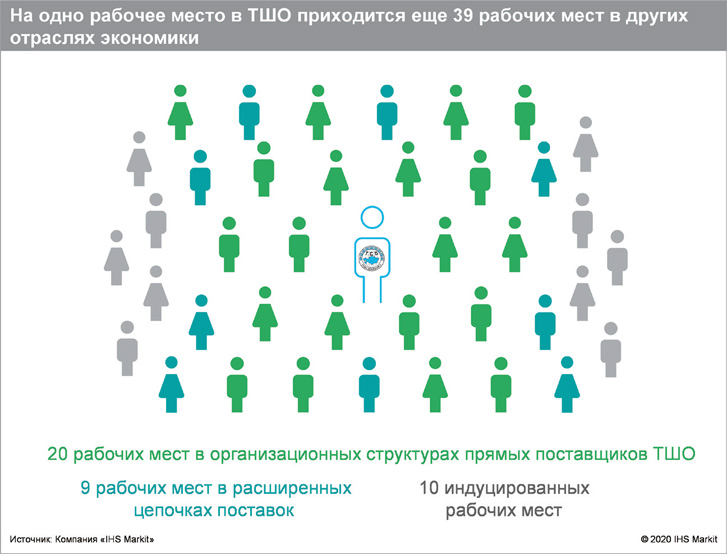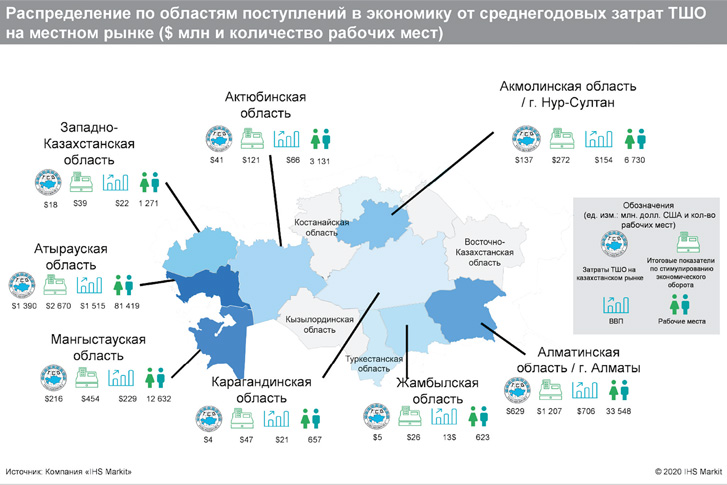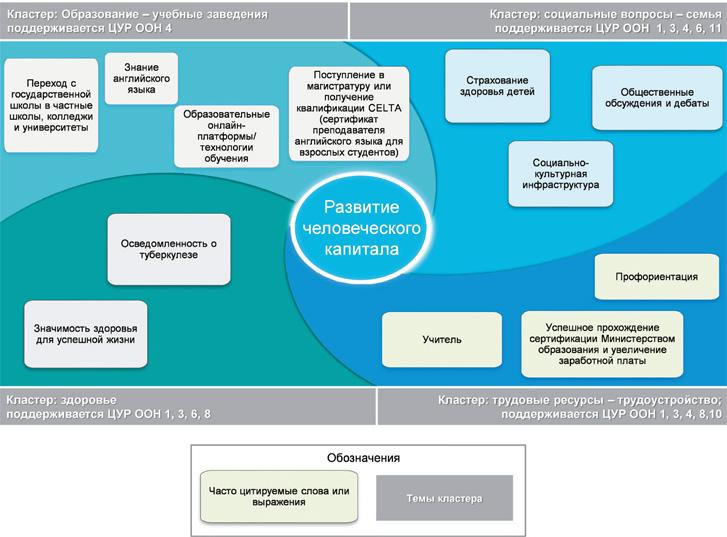KAZENERGY-KIOGE
Every dollar of local spending by TCO triggers another dollar of economic turnover
Tengizchevroil LLP (TCO) is the leader of oil and gas industry in Kazakhstan. Since its establishment in April 1993, TCO has invested and continues to invest in major capacity expansion projects that have increased the annual total oil production at Tengiz and Korolev fields by almost 15 times: from 1.9 million tons per year (42,000 barrels per day) in 1994 to 29.8 million tons per year (651,300 barrels per day) in 2019. TCO has been the largest taxpayer in Kazakhstan for many years. However, TCO’s contribution to the national economy is not limited to volumes of oil and gas production and amounts of taxes paid. The multiplicative effect of the joint venture activities has a beneficial effect on the sustainable development of the Republic of Kazakhstan.
In collaboration with a team of experts from KIMEP University, IHS Markit, the respected research company, analyzed TCO’s oil and gas production activities, the effects of TCO spending on the national economy development, as well as the contributions from the social investment program to the country’s sustainable development during the period 2010 through 2019.
Kazakhstani Content Development

To carry out its activities, TCO makes direct purchases of goods and services from Kazakhstani manufacturers, which ensures not only stable cash flows to the country’s economy, but also creation of new jobs, development of local companies, and an increase in tax payments. From 2010 through 2019, TCO spent a total of close to $24.4 billion with local Kazakhstani businesses or an average of $2.4 billion annually. After making calculations using a suite of custom economic models, IHS Markit concluded that the $2.4 billion that TCO spent annually in Kazakhstan triggered almost $ 1.4 billion of follow-on supply chain-related sales as additional indirect economic activity.
Another type of economic activity, known as induced activity, was also measured using IHS Markit models. This is such kind of activity when employees who are paid by either TCO or contracting and subcontracting companies spend large portions of their income on purchases within Kazakhstan. According to this model, the $2.4 billion of annual local spending by TCO led to an average of $1 billion of sales activity. Thus, TCO’s spending for purchasing goods and services within Kazakhstan led to indirect and induced economic activity in the amount of $2.4 billion. In simple words, every dollar of local spending by TCO leads to another dollar of sales activity in the national economy.
After TCO purchases goods and services from domestic suppliers, these companies transform non-labor inputs into higher-value products or services, which are then delivered to TCO. This transformation process also occurs through the indirect and induced cycles. In economics parlance, the difference between the sales price and non-labor input costs is known as value added.
Companies usually use value added for three main purposes: paying employees, paying taxes and generating profits. Thus, value added allows Kazakhstani companies to hire and retain employees and Kazakhstani employees to have a stable workplace and feed their families. IHS Markit estimates that TCO’s local spending ultimately allowed the direct, indirect and induced companies to hire and retain, on average, over 140,000 workers.
It is also important to consider how many jobs are supported in Kazakhstan for each job at TCO. Over the study period, TCO employed an average of 3,654 Kazakh nationals while its direct local spending ultimately supported over 140,000 jobs. Thus, for every TCO job, there are another 39 jobs across the economy, creation of which was facilitated by TCO.

According to IHS Markit, those 39 jobs are distributed across industries as follows:
- Construction: 10 jobs
- Professional services: 8 jobs
- Transportation and storage: 5 jobs
- Wholesale and retail: 4 jobs
- Manufacturing: 3 jobs
- Accommodation and food services: 3 workplaces
- Other industries: 6 jobs
TCO’s local spending by regions of Kazakhstan
While TCO oil production operations are centered in Atyrau oblast, the company’s average annual spending and economical benefit transcend multiple regions.

The graphic shows how TCO’s local spending impacts various oblasts/regions as measured by sales activity, GDP contribution, and quantity of jobs. The total sales stimulated is the sum of TCO’s direct local spending plus any subsequent indirect and induced sales. For a given oblast, the total sales stimulated is roughly twice TCO’s local spending. Because an extended supply chain likely crosses multiple oblast borders, a direct purchase by TCO in one oblast may stimulate sales further down the supply chain in another oblast. For example, buying construction services in Atyrau may eventually stimulate sales in Mangystau’s manufacturing sector.
Social investments
The Republic of Kazakhstan has a goal to become part of the Organization for Economic Cooperation and Development’s (OECD) group of 30 most developed nations. IHS Markit reviewed social investment projects and programs funded by TCO and assessed how they supported the Republic of Kazakhstan’s development goals. Two frameworks were used for the assessment: Kazakhstan’s 2025 Strategic Reform goals and the United Nations Sustainable Development goals.
For the period 2010 through 2019, TCO implemented around 100 unique social investment projects, which cumulatively totaled $367.2 million. The analysis found TCO’s social investments are having a transformative effect on Kazakhstan mainly through building human capital. This impact occurs through the two main channels: education (both formal and informal) and encouraging new opportunities for work through skill development and improved working conditions. Textual cluster analysis of the interview identified 4 clusters that all were components of human capital development: education, family, health, and labor.

Importantly, many of TCO social programs help underserved populations and create spaces for innovation and creativity. For example, TCO has funded the building of schools, which helps to set children on a path to higher education. They have also built youth centers that offer opportunities for technical and vocational training. Through programs like TECH Teens and TECH Teachers, technology skills have been built that offer new opportunities for work. Although education and new career development opportunities are the two primary channels through which TCO has contributed to the development of Kazakhstan’s human capital, the company also contributes significantly to the health of the population through programs like Project Hope that raises awareness about tuberculosis and how to prevent it, working with Kazakhstan Physicians to reduce cardiovascular disease. In addition, TCO donates special-purpose equipment to Kazakhstan medical institutions.
These projects and programs will have lasting effects for economic growth and development as they have helped diversify the economy, increase local employment, and increase innovation and entrepreneurship. These social investments directly impact the goals at both the national level (Kazakhstan’s Strategic Reform goals) and the global level (UN Sustainable Development Goals [SDGs]). They are helping to develop Kazakhstan to achieve its ultimate goal of entering the group of 30 most developed nations.



